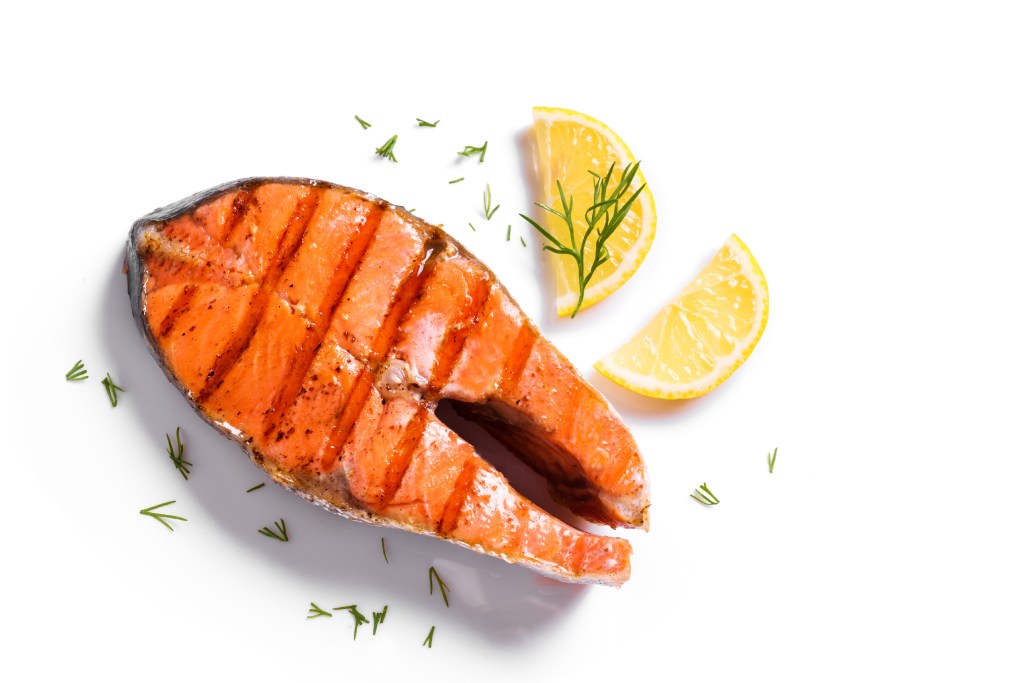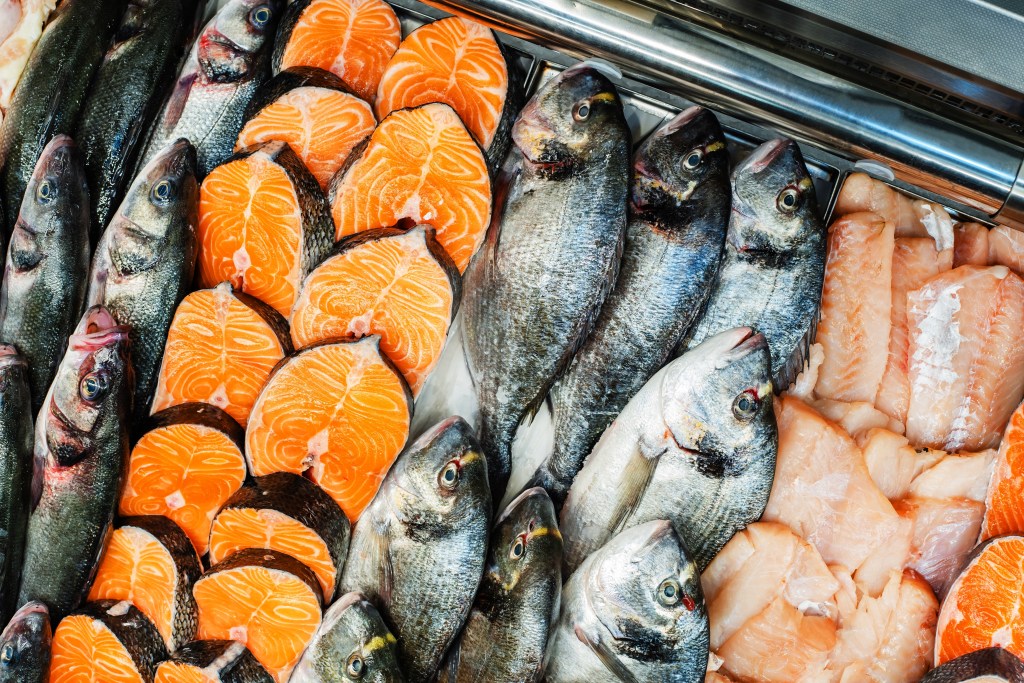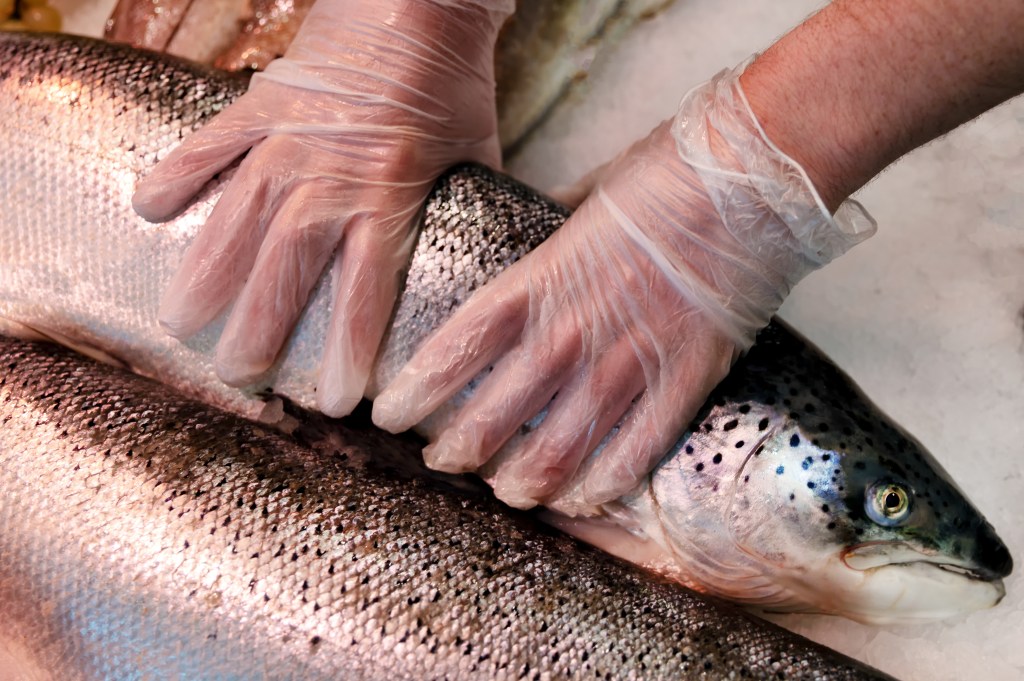At a glance
Cod and salmon are both versatile and flavorful fish, but their nutrient density differs significantly. Cod is lean and low in calories, while salmon offers abundant omega-3 fats and a broader range of vitamins and minerals. Choosing wild-caught varieties provides superior nutrition and helps minimize exposure to contaminants.
Cod vs. salmon–which one is the better choice?
While both cod fish and salmon offer plenty of protein, salmon has a superior nutritional profile, and regularly consuming this oily fish has been linked to various impressive health benefits.
Let’s look at the difference between salmon and cod and find out why choosing wild-caught salmon is one of the best options for your health.
What is cod fish?
Cod is a type of white fish known for its mild flavor and flaky texture. Atlantic cod is primarily found in the North Atlantic, while Pacific cod is native to the colder waters of the North Pacific Ocean.
Known for its mild flavor and flaky texture, cod is a versatile fish that can be prepared in many ways, such as grilled, baked, fried, or poached.
Cod is consumed worldwide, particularly in North America, Europe, and Asia. In the United States, cod is frequently used in seafood chowders, fish tacos, and baked or fried fish dishes.
Here’s the nutritional value of a three-ounce serving of Atlantic cod:
- 90 calories
- 1 g fat
- 22 g protein
- 0 g carbohydrates
In addition to being a lean protein source, cod contains small amounts of essential vitamins and minerals. These include vitamins B1, B3, B6, and B12, as well as folate and selenium, which support various crucial bodily functions, including energy production and immune health.
Watch the video below to discover whether salmon or cod is better for your health.
Benefits and downsides of cod
Eating fish is widely regarded as a nutritious choice, and cod is no exception.
Research published in Nutrition, Metabolism, and Cardiovascular Disease found that regular cod consumption can support weight loss, likely due to its low-calorie content.1
In addition, cod is an excellent source of protein, essential for muscle repair, hormone synthesis, and overall body function. It’s also rich in essential nutrients such as B vitamins and selenium, which promote energy-making processes and detoxification pathways.
However, there are some downsides to consider. Because cod contains less fat and fewer calories than other types of fish, it isn’t very satiating. This can leave some individuals feeling hungry sooner after a meal.
Additionally, most commercial cod products come from farmed fish, which may contain higher levels of contaminants, such as antibiotics, environmental pollutants, and heavy metals, including mercury, compared to wild-caught cod.
Pregnant women and young children should be cautious when consuming factory-farmed cod due to potential mercury exposure, although it generally has lower mercury levels than larger fish species such as swordfish or tuna.

What is salmon?
Salmon is a highly nutritious oily fish with a rich flavor and tender, flaky texture. It’s a popular choice in many cuisines worldwide and commonly enjoyed as grilled filets, sushi, or smoked salmon.
Atlantic salmon is primarily found in the North Atlantic, while Pacific salmon is native to the North Pacific Ocean, including coastal regions of North America and parts of Asia.
Here’s the nutritional value of a three-ounce serving of Atlantic salmon:
- 180 calories
- 10 g fat
- 25 g protein
- 0 g carbohydrates
“Similar to cod, salmon contains essential B vitamins and selenium,” explains Dr. Berg. “However, salmon offers up to four times the amount of these nutrients, making it a far more nutritious choice.”
Furthermore, salmon boasts an exceptionally high concentration of heart-healthy omega-3 fatty acids. A three-ounce serving of salmon provides approximately 2200 mg of omega-3 fats, which is significantly higher than the 170 mg found in cod.

Benefits and downsides of salmon
Salmon is renowned for its high omega-3 fatty acid content, which offers a wide range of health benefits. These healthy fats are known for their potential to reduce inflammation, lower blood pressure, and improve cholesterol levels.
Research published in StatPearls summarizes the health benefits of omega-3 fats as follows, “In addition to their well-established lipid-lowering effects, these acids exhibit anti-inflammatory, antiarrhythmic, and vasodilatory properties, influencing atherosclerotic processes and cardiac rhythm regulation.”2
Omega-3 fatty acids have shown potential therapeutic benefits for various conditions, such as:
- Heart disease
- Type 2 diabetes
- Alzheimer’s disease and dementia
- Depression
- Rheumatoid arthritis
- Autoimmune conditions
- Asthma
- Periodontal disease
- Epilepsy
- Diabetic retinopathy
- Premenstrual syndrome
- Non-alcoholic fatty liver disease (NAFLD)
While salmon’s high omega-3 content offers many impressive benefits, consuming farmed salmon products may undermine these advantages.
Farmed salmon can contain contaminants such as antibiotics, pesticides, polychlorinated biphenyls (PCBs), and heavy metals. In addition, factory-farmed salmon are typically fed synthetic astaxanthin, an artificial food dye that gives the fish their distinct pink color.
Unlike the natural astaxanthin found in wild salmon, which is derived from their diet of krill and other small marine organisms, synthetic astaxanthin is chemically manufactured and may have potential health risks when consumed in large amounts.
Research published in Environmental Health Perspectives indicates that frequent intake of farm-raised salmon can cause health concerns and may increase the risk of various cancers, fertility problems, and hormonal imbalances.3

Cod vs. salmon: which should you choose?
When choosing between cod and salmon, salmon is the better option due to its superior nutritional profile.
While both fish offer high-quality protein, salmon provides significantly higher concentrations of health-promoting omega-3 fatty acids.
Salmon also contains more B vitamins and trace minerals and is one of the few dietary sources of vitamin D3, which is essential for bone health, strong immune defenses, and brain functions.
Although cod is lower in calories, it lacks the beneficial fats and other essential nutrients found in salmon. This makes salmon a more nutrient-dense choice for supporting heart health and promoting overall well-being.

Tips for choosing healthy fish
When choosing fish, it’s crucial to consider both nutritional value and environmental impact.
Opting for sustainable fish ensures that the fish you consume is harvested in a way that protects natural ecosystems and fish populations.
Wild-caught fish are the best choice, as they tend to contain fewer contaminants than farmed fish, thereby minimizing your exposure to potentially harmful toxins, pollutants, antibiotics, and artificial dyes.
Look for products labeled wild-caught and certified by the Marine Stewardship Council (MSC), which typically indicates that the fish has been harvested responsibly.
Wild-caught fish not only boast a more robust nutritional profile compared to farmed fish, but they also tend to have fewer contaminants and lower mercury levels, depending on their species.
This is an especially important consideration for pregnant women as high mercury exposure can harm fetal brain and nervous system development.
However, it’s important to note that salmon and cod are good sources of selenium, which helps counteract mercury’s potentially harmful effects by binding to this heavy metal and reducing its toxicity.
Out of an abundance of caution, the Food and Drug Administration (FDA) recommends that pregnant women consume no more than three servings of low-mercury fish species such as salmon or cod per week.
Key takeaways
- Both cod and salmon provide high-quality protein, but salmon contains significantly more omega-3 fatty acids, essential vitamins, and trace minerals.
- Cod is leaner and lower in calories, though it provides fewer healthy fats and may be less satiating.
- Opting for sustainably sourced, wild-caught fish helps ensure superior nutrition and lower exposure to environmental toxins than farmed fish.
FAQ
1. Cod vs. salmon: which is better for you?
Compared to cod, wild-caught salmon is nutritionally superior, offering exceptionally high levels of omega-3 fatty acids, which are known to improve heart health, regulate blood pressure, and support glycemic control.
Salmon also contains significantly higher concentrations of essential nutrients, including vitamins B1, B3, B6, and B12, in addition to folate and selenium. This makes salmon the better choice for promoting optimal nutrient intake and supporting a healthy body.
2. What is the healthiest fish to eat?
Wild-caught salmon is one of the most nutritious fish available. It’s an excellent source of heart-healthy omega-3 fatty acids, high-quality protein, and essential vitamins and trace minerals.
Additionally, compared to other oily fish species, such as tuna and swordfish, salmon is considered a low-mercury fish, making it a safe choice for regular consumption.
3. Is cod a good substitute for salmon?
No, cod isn’t a good substitute for salmon. Salmon is rich in health-promoting omega-3 fatty acids, which contribute to its smooth, rich texture and flavorful taste.
In contrast, cod is much leaner and contains minimal amounts of healthy fats, giving it a firmer, flakier texture and a milder flavor.
4. Does cod or salmon have more mercury?
Generally, salmon has lower mercury levels than cod, as salmon is smaller and has a shorter lifespan, leading to less mercury accumulation within the fish’s tissue.
5. Can you combine a pescatarian and keto diet?
Yes, it’s possible to follow a pescatarian ketogenic diet by focusing on low-carb, high-fat foods primarily from fish, shellfish, and plant-based sources.
Consuming plenty of fatty fish such as salmon, mackerel, and sardines, in addition to non-starchy vegetables, avocados, nuts, seeds, and healthy oils, helps meet the body’s energy requirements while maintaining ketosis.
Sources
- https://pubmed.ncbi.nlm.nih.gov/19356912/ ?
- https://www.ncbi.nlm.nih.gov/books/NBK564314/ ?
- https://pmc.ncbi.nlm.nih.gov/articles/PMC1257546/ ?
















